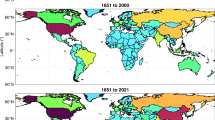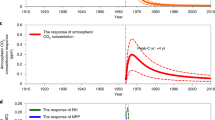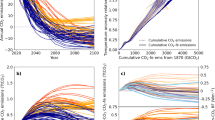Abstract
Knowledge of the contribution that individual countries have made to global radiative forcing is important to the implementation of the agreement on “common but differentiated responsibilities” reached by the United Nations Framework Convention on Climate Change. Over the past three decades, China has experienced rapid economic development1, accompanied by increased emission of greenhouse gases, ozone precursors and aerosols2,3, but the magnitude of the associated radiative forcing has remained unclear. Here we use a global coupled biogeochemistry–climate model4,5 and a chemistry and transport model6 to quantify China’s present-day contribution to global radiative forcing due to well-mixed greenhouse gases, short-lived atmospheric climate forcers and land-use-induced regional surface albedo changes. We find that China contributes 10% ± 4% of the current global radiative forcing. China’s relative contribution to the positive (warming) component of global radiative forcing, mainly induced by well-mixed greenhouse gases and black carbon aerosols, is 12% ± 2%. Its relative contribution to the negative (cooling) component is 15% ± 6%, dominated by the effect of sulfate and nitrate aerosols. China’s strongest contributions are 0.16 ± 0.02 watts per square metre for CO2 from fossil fuel burning, 0.13 ± 0.05 watts per square metre for CH4, −0.11 ± 0.05 watts per square metre for sulfate aerosols, and 0.09 ± 0.06 watts per square metre for black carbon aerosols. China’s eventual goal of improving air quality will result in changes in radiative forcing in the coming years: a reduction of sulfur dioxide emissions would drive a faster future warming, unless offset by larger reductions of radiative forcing from well-mixed greenhouse gases and black carbon.
This is a preview of subscription content, access via your institution
Access options
Subscribe to this journal
Receive 51 print issues and online access
$199.00 per year
only $3.90 per issue
Buy this article
- Purchase on Springer Link
- Instant access to full article PDF
Prices may be subject to local taxes which are calculated during checkout




Similar content being viewed by others
References
National Bureau of Statistics of China. Gross Domestic Product Index Since 1978 http://data.stats.gov.cn/english/easyquery.htm?cn=C01 (see ‘National Accounts’ for GDP) (2014)
Boden, T. A., Marland, G. & Andres, R. J. Global, Regional, and National Fossil-Fuel CO 2 Emissionshttp://dx.doi.org/10.3334/CDIAC/00001_V2013 (Carbon Dioxide Information Analysis Center, Oak Ridge National Laboratory, US DOE, 2013)
Emission Database for Global Atmospheric Research (EDGAR) Release version 4.2, http://edgar.jrc.ec.europa.eu (European Commission, Joint Research Centre, Netherlands Environmental Assessment Agency, 2011)
Gasser, T. Attribution Régionalisée des Causes Anthropiques du Changement Climatiquehttps://tel.archives-ouvertes.fr/tel-01135456, PhD thesis, Univ. Pierre et Marie Curie (2014)
Cherubini, F., Gasser, T., Bright, R. M., Ciais, P. & Stromman, A. H. Linearity between temperature peak and bioenergy CO2 emission rates. Nature Clim. Change 4, 983–987 (2014)
Hauglustaine, D. A. et al. Interactive chemistry in the Laboratoire de Météorologie Dynamique general circulation model: description and background tropospheric chemistry evaluation. J. Geophys. Res. 109, D04314 (2004)
Myhre, G. et al. in Climate Change 2013: The Physical Science Basis. Contribution of Working Group I to the Fifth Assessment Report of the Intergovernmental Panel on Climate Change (eds Stocker, T. F. et al..) 659–740 (Cambridge Univ. Press, 2013)
Boisier, J. P., de Noblet-Ducoudré, N. & Ciais, P. Inferring past land use-induced changes in surface albedo from satellite observations: a useful tool to evaluate model simulations. Biogeosciences 10, 1501–1516 (2013)
Ciais, P. et al. Attributing the increase in atmospheric CO2 to emitters and absorbers. Nature Clim. Change 3, 926–930 (2013)
Höhne, N. et al. Contributions of individual countries emissions to climate change and their uncertainty. Clim. Change 106, 359–391 (2011)
United Nations Framework Convention on Climate Change (UNFCCC). Methodological Issues: Scientific and Methodological Assessment of Contributions to Climate Change, Report of the Expert Meeting, Note by the Secretariat, http://unfccc.int/resource/docs/2002/sbsta/inf14.pdf (UNFCCC, 2002)
Trudinger, C. & Enting, I. Comparison of formalisms for attributing responsibility for climate change: non-linearities in the Brazilian proposal approach. Clim. Change 68, 67–99 (2005)
Houghton, R. A. & Hackler, J. L. Sources and sinks of carbon from land-use change in China. Glob. Biogeochem. Cycles 17, 1034 (2003)
Piao, S. L. et al. The carbon balance of terrestrial ecosystems in China. Nature 458, 1009–1013 (2009)
Jain, A. K., Meiyappan, P., Song, Y. & House, J. I. CO2 emissions from land-use change affected more by nitrogen cycle, than by the choice of land-cover data. Glob. Change Biol. 19, 2893–2906 (2013)
Davis, S. J., Matthews, D. & Caldeira, K. Future CO2 emissions and climate change from existing energy infrastructure. Science 329, 1330–1333 (2010)
Ha-Duong, M., Grubb, M. J. & Hourcade, J. C. Influence of socioeconomic inertia and uncertainty on optimal CO2-emission abatement. Nature 390, 270–273 (1997)
Boucher, O. & Reddy, M. S. Climate trade-off between black carbon and carbon dioxide emissions. Energy Policy 36, 193–200 (2008)
Shindell, D. et al. Simultaneously mitigating near-term climate change and improving human health and food security. Science 335, 183–189 (2012)
Klimont, Z., Smith, S. J. & Cofala, J. The last decade of global anthropogenic sulphur dioxide: 2000–2011 emissions. Environ. Res. Lett. 8, 014003 (2013)
Huneeus, N., Boucher, O. & Chevallier, F. Atmospheric inversion of SO2 and primary aerosol emissions for the year 2010. Atmos. Chem. Phys. 13, 6555–6573 (2013)
Boucher, O. et al. in Climate Change 2013: The Physical Science Basis. Contribution of Working Group I to the Fifth Assessment Report of the Intergovernmental Panel on Climate Change (eds Stocker, T. F. et al..) 571–657 (Cambridge Univ. Press, 2013)
Carslaw, K. S. et al. Large contribution of natural aerosols to uncertainty in indirect forcing. Nature 503, 67–71 (2013)
Yu, H. et al. A multimodel assessment of the influence of regional anthropogenic emission reductions on aerosol direct radiative forcing and the role of intercontinental transport. J. Geophys. Res. 118, 700–720 (2013)
Gasser, T. & Ciais, P. A theoretical framework for the net land-to-atmosphere CO2 flux and its implications in the definition of “emissions from land-use change”. Earth Syst. Dyn. 4, 171–186 (2013)
Wang, R. et al. High-resolution mapping of combustion processes and implications for CO2 emissions. Atmos. Chem. Phys. 13, 5189–5203 (2013)
Zhou, F. et al. A new high-resolution N2O emission inventory for China in 2008. Environ. Sci. Technol. 48, 8538–8547 (2014)
Stohl, A. et al. Evaluating the climate and air quality impacts of short-lived pollutants. Atmos. Chem. Phys. 15, 10529–10566 (2015)
Granier, C. et al. Evolution of anthropogenic and biomass burning emissions of air pollutants at global and regional scales during the 1980–2010 period. Clim. Change 109, 163–190 (2011)
Fry, M. M. et al. The influence of ozone precursor emissions from four world regions on tropospheric composition and radiative climate forcing. J. Geophys. Res. 117, D07306 (2012)
Acknowledgements
We thank M. Schulz for help with Supplementary Fig. 7, and H. Yu for sharing data from ref. 24. This study is supported by the National Natural Science Foundation of China (grant numbers 41371443, 41390240) and the 111 project (grant number B14001). It is also part of the ACACCYA project funded by the GIS Climat-Environnement-Société. T.G. is supported by the European Research Council Synergy grant ERC-2013-SyG-610028 IMBALANCE-P.
Author information
Authors and Affiliations
Contributions
B.L., T.G., P.C., S. Piao and S.T. designed the study. Simulations and output analysis were performed by T.G. for OSCAR and the overall integration; by D.H., R.W. and Y.B. for LMDz-INCA; by J.-P.B. and L.Z.L. for LUC albedo reconstructions; by Y.B. for black carbon albedo; by Z.C. and Y.B. for secondary organic aerosols; and by B.L., T.G., D.H. and R.W. for model evaluation. B.L., S. Peng, Y.Y. and F.Z. provided additional data and analysis. Writing was led by B.L., with substantial inputs from T.G., P.C., S. Piao, S.T., Y.B., D.H. and R.W. All authors participated in the study, the interpretation of the results, and the outline of the paper, through regular meetings and discussion over the past three years.
Corresponding author
Ethics declarations
Competing interests
The authors declare no competing financial interests.
Supplementary information
Supplementary Information
This file contains a Supplementary Discussion, Supplementary Methods, additional references, Supplementary Tables 1-2 and Supplementary Figures 1-9. (PDF 3695 kb)
Supplementary Data
This zipped file contains the source code of OSCAR, used to estimate China’s contribution to WMGHGs and to perform the overall integration and uncertainty analysis, along with any input data used in this study. (ZIP 19740 kb)
Rights and permissions
About this article
Cite this article
Li, B., Gasser, T., Ciais, P. et al. The contribution of China’s emissions to global climate forcing. Nature 531, 357–361 (2016). https://doi.org/10.1038/nature17165
Received:
Accepted:
Published:
Issue Date:
DOI: https://doi.org/10.1038/nature17165
This article is cited by
-
Constrained tropical land temperature-precipitation sensitivity reveals decreasing evapotranspiration and faster vegetation greening in CMIP6 projections
npj Climate and Atmospheric Science (2023)
-
Can Chinese outward foreign direct investment help the belt and road low-carbon development? Evolutionary game in China’s environmental responsibility
Environment, Development and Sustainability (2023)
-
Sulfur emissions from consumption by developed and developing countries produce comparable climate impacts
Nature Geoscience (2022)
-
Updated Simulation of Tropospheric Ozone and Its Radiative Forcing over the Globe and China Based on a Newly Developed Chemistry-Climate Model
Journal of Meteorological Research (2022)
-
An evolutionary analysis of low-carbon technology investment strategies based on the manufacturer-supplier matching game under government regulations
Environmental Science and Pollution Research (2022)
Comments
By submitting a comment you agree to abide by our Terms and Community Guidelines. If you find something abusive or that does not comply with our terms or guidelines please flag it as inappropriate.



